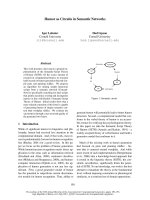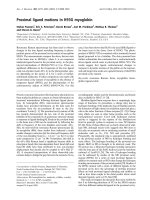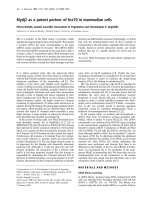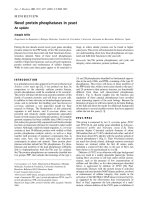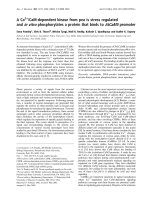Báo cáo y học: "Microparticles as biomarkers in autoimmunity: from dust bin to center stage" potx
Bạn đang xem bản rút gọn của tài liệu. Xem và tải ngay bản đầy đủ của tài liệu tại đây (45.31 KB, 2 trang )
Available online />Page 1 of 2
(page number not for citation purposes)
Abstract
Microparticles are small membrane-bound vesicles released from
activated and dying cells. As shown in a study of primary Sjogren’s
syndrome, systemic lupus erythematosus and rheumatoid arthritis,
levels of microparticles in the blood, as measured by a solid-phase
prothrombinase assay or flow cytometry, are increased with
autoimmunity. Among patients with these conditions, however,
particle numbers were inversely related to disease activity and
levels of the enzyme secretory phospholipase A
2
that can digest
membrane lipids and perhaps cause particle loss. These findings
suggest microparticles as novel biomarkers for autoimmunity, with
levels reflecting events leading to their loss as well as production.
The development of biomarkers for autoimmunity is a major
undertaking critical to elucidating disease pathogenesis and
assessing disease activity in routine care as well as in clinical
trials. In general, biomarkers represent products of cells (for
example, cytokines) or phenotypic or functional changes in
cells usually sampled from the blood. These changes include
the expression of cell surface markers or patterns of gene
expression. As shown in the previous issue of Arthritis
Research and Therapy, subcellular fragments called micro-
particles (MPs) may represent novel biomarkers that can
occupy an important place between small molecules and the
cells in the hierarchy of markers [1].
MPs are small membrane-bound vesicles released from
activated or dying cells. Once viewed as inert debris or
cellular dust, MPs have emerged as important mediators of
intercellular communication with pleiotropic activities [2,3].
Indeed, because of their content of lipids, proteins and nucleic
acids, MPs can stimulate diverse physiologic processes such
as thrombosis and the activation of immune cells, endothelial
cells and fibroblasts [2,4-6]. The activity of MPs is impressive,
perhaps related to their rich content of bioactive molecules,
with their concentration in a single packet simultaneously
triggering multiple signaling systems.
As markers, MPs are unusual since their origin appears to
result from disparate processes. MP release thus occurs with
both cell activation and cell death. This seeming paradox
could result from the differences in the behavior of cell types
as well as the experimental systems used to elucidate the
release process. The study of particle release during activa-
tion has therefore primarily focused on platelets, while the
release of particles during death has involved nucleated cells
(for example, lymphocytes or monocytes) undergoing apop-
tosis. While nucleated cells may release particles during
activation, the occurrence of activation-induced cell death
may confound interpretation of this process [7,8].
In their study, Sellam and colleagues used two different ana-
lytic approaches: a solid-phase assay based on the prothrom-
binase activity of MPs, and conventional flow cytometry. Each
assay has limitations. The functional assay depends on MP
capture by either annexin V or antibodies to cell surface
molecules and is based on the assumption that all particles
have prothrombinase activity; since many particles do not
bind annexin, however, their presence can be missed.
Similarly, flow cytometry can be limited by the small size of
particles (0.1 to 1.0 μM). Depending on the thresholds for
detection by flow cytometry, many particles may be missed
with light scatter. Counting of MPs by staining with
antibodies to cell surface markers can be problematic
because the small surface area of MPs (approximately 100 to
10,000 times smaller than a cell) allows binding of miniscule
amounts of antibody and leads to weak signals.
Notwithstanding these issues, Sellam and colleagues provide
compelling evidence that MP levels are elevated in the
Editorial
Microparticles as biomarkers in autoimmunity: from dust bin to
center stage
David S Pisetsky
Medical Research Service, Durham VA Medical Center, Division of Immunology and Rheumatology, Duke University Medical Center, 151G Durham
VAMC, 508 Fulton Street, Durham, NC 27705, USA
Corresponding author: David S Pisetsky,
Published: 30 November 2009 Arthritis Research & Therapy 2009, 11:135 (doi:10.1186/ar2856)
This article is online at />© 2009 BioMed Central Ltd
See reltade research by Sellam et al., />MP = microparticle.
Arthritis Research & Therapy Vol 11 No 6 Pisetsky
Page 2 of 2
(page number not for citation purposes)
plasma of patients with primary Sjogren’s syndrome, systemic
lupus erythematosus and rheumatoid arthritis [1]. For all three
diseases, the levels of platelet MPs were the highest – and
only in the plasma of patients with primary Sjogren’s syn-
drome did levels of leukocyte MPs exceed those of controls.
These results are surprising in view of evidence for extensive
immune cell activation in this group of diseases [9]. The
failure to demonstrate leukocyte MPs may reflect the assay
systems, the patient population and the range of disease
activity in patients studied.
While immune cell activation may cause MP release, the
numbers may be small, with those particles released not
found because of detection problems, binding to cells or
clearance by macrophages/monocytes. Because of their
display of cell surface markers such as phosphatidyl serine,
MPs – like apoptotic cells – may be targets for phagocytic
cell uptake because of their exposure of ‘eat me’ signals;
these signals may be present even for particles from
activated cells. Nevertheless, the finding of increased platelet
MPs is important since these diseases all have a vascular
component, with increased MPs potentially promoting
thrombosis in a manner similar to that postulated for
atherosclerosis, stroke and diabetes [10].
A curious aspect of Sellam and colleagues’ study relates to
the inverse relationship between MP numbers and disease
activity. Since MP numbers are increased in the blood with
autoimmune disease, the highest numbers would be expected
in patients with the most active or severe disease. Instead,
the authors found the opposite result, with particle numbers
inversely released to extraglandular disease in primary
Sjogren’s syndrome, for example. Among explanations for this
surprising finding, Sellam and colleagues suggest the
possibility that an increase in the level of secretory phospho-
lipase A
2
could lead particle destruction via enzymatic diges-
tion of membrane lipids. In that case, secretory phospholipase
A
2
may play an important role in homeostasis by a reducing a
prothombotic and immunostimulatory blood component.
While this study raises many questions about the relationship
between particle production and disease activity, it is
nevertheless important in putting MPs center stage as
disease markers and showing how the components in the
blood can be mined in new and intriguing ways.
Competing interests
The author declares that they have no competing interests.
Acknowledgements
DSP is supported by a VA Merit Review Grant, a grant from the
Alliance for Lupus Research, and NIH grant AI083923.
References
1. Sellam J, Proulle V, Jungel A, Ittah M, Miceli-Richard C, Gotten-
berg JE, Toti F, Benessiano J, Gay S, Freyssinet JM, Mariette X:
Increased levels of circulating microparticles in primary Sjö-
gren’s syndrome, systemic lupus erythematosus and rheuma-
toid arthritis and relation with disease activity. Arthritis Res
Ther 2009, 11:R156.
2. Distler JH, Pisetsky DS, Huber LC, Kalden JR, Gay S, Distler O:
Microparticles as regulators of inflammation: novel players of
cellular crosstalk in the rheumatic diseases. Arthritis Rheum
2005, 52:3337-3348.
3. Piccin A, Murphy WG, Smith OP: Circulating microparticles:
pathophysiology and clinical implications. Blood Rev 2007, 21:
157-171.
4. Mesri M, Altier DC: Leukocyte microparticles stimulate
endothelial cell cytokine release and tissue factor induction in
a JNK1 signaling pathway. J Biol Chem 1999, 274:23111-
23118.
5. Ratajczak J, Wysoczynski M, Hayek F, Janowska-Wieczorek A,
Ratajczak MZ: Membrane-derived microvesicles: important
and underappreciated mediators of cell-to-cell communica-
tion. Leukemia 2006, 20:1487-1495.
6. Martinez MC, Larbret F, Zobairi F, Coulombe J, Debili N,
Vainchenker W, Ruat M, Freyssinet JM: Transfer of differentia-
tion signal by membrane microvesicles harboring hedgehog
morphogens. Blood 2006, 108:3012-3020.
7. Lynch SF, Ludlam CA: Plasma microparticles and vascular dis-
orders. Br J Haematol 2007, 137:36-48.
8. Distler JHW, Huber LC, Hueber AJ, Reich CF, Gay S, Dister O,
Pisetsky DS: The release of microparticles by apoptotic cells
and their effects on macrophages. Apoptosis 2005, 10:731-
741.
9. Liu CC, Ahearn JM: The search for lupus biomarkers. Best
Pract Res Clin Rheumatol 2009, 23:507-523.
10. VanWijk MJ, VanBavel E, Sturk A, Nieuwland R: Microparticles in
cardiovascular diseases. Cardiovasc Res 2003, 59:277-287.

